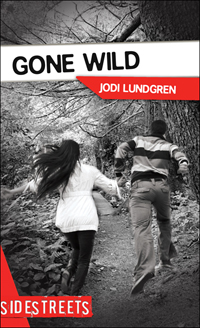| ________________
CM . . .
. Volume XXII Number 16. . . .December 18, 2015

 |
Gone Wild. (SideStreets).
Jodi
Lundgren.
Toronto, ON: James Lorimer, 2015.
172 pp., pbk., hc. & epub, $9.95 (pbk).
ISBN 978-1-4594-0988-0 (pbk.), ISBN 978-1-4594-0989-7 (hc.), ISBN 978-1-4594-0990-3 (epub).
Grades 9-11 / Ages 14-16.
Review by Gillian Lapenskie.
**½ /4
|
| |
|

Jodi Lundgren’s new novel for teens, Gone Wild, is set on the Juan de Fuca Marine Trail. The trail is not far from Victoria, BC, where Lundgren currently lives, and it provides a unique backdrop for the brief but significant journey of the novel’s main characters.
The novel’s narrative perspective alternates between Seth and Brooke, teenagers who are both hiking the trail alone. Though they have very different reasons for being there, both teens are trying to escape from their problems and from the adults in their lives who don’t seem to understand them. After swapping points of view for the first half of the novel, the two meet and eventually team up in chapter 12. Brooke and Seth are dealing with contrasting issues that Lundgren tries to connect, with some success. Brooke believes she is pregnant as the result of having unprotected sex with her boyfriend. Seth’s home life is pretty grim, and his search for his birth parents has just hit a road block because he found out he’s too young to access the adoption registry. Lundgren also briefly touches on the distinct possibility that Seth is First Nations and how that may be a factor in his developing identity.
Though Lundgren’s dialogue seems a bit artificial at times, particularly when it involves parents, her description is vivid, and it gives the novel a lot of atmosphere. Details about the trail, the vegetation, and the wildlife are evocative and realistic. There are plenty of natural hazards for the two teens to contend with on the trail: rough terrain, a bear sighting, deep mud, and the ocean. Unlike Brooke, who has spent time in the wilderness and loves being there, Seth is totally unprepared for these experiences. Because Seth’s escape from the city was unplanned, he doesn’t have the supplies needed to spend a few nights in the woods. Whether they want it or not, these two strangers need each other’s help in order to survive.
The empty stretch of beach seemed peaceful just minutes ago. Now it seems spooky. It’s so wide and so deserted. A cougar could be watching from the trees.... She gives a jolt when she sees a skinny young guy with a stringy mop of brown hair, rifling through her food sac. “Hey! That’s my food!” She leaps onto the platform and grabs her bag.
He gasps and makes to dart away, but she seizes his arm.
“Let go of me!”
“Just hang on. Don’t you have any food of your own?”
He scowls. “Where would I get food? You see a grocery store around here?” He wrenches himself free of her grip.
He’s wearing cargo pants and a long sleeved t-shirt with holes at the cuffs. His running shoes aren’t heavy enough for the trail. His face is streaked with dirt and bits of dried food. Twigs are caught in his hair, which is forming into matted clumps. He’s jittery, shaking lightly all over. He flicks his hair off his face.
He looks more like a homeless kid than a hiker. What’s he doing out here alone?
The novel contains many references to Brooke’s period, her probable miscarriage, and Seth’s bout of diarrhea. These elements could make classroom discussion a bit challenging and might even be distracting for some readers who aren’t yet mature enough to handle this kind of content. Otherwise, it’s easy to see the potential for using this novel in an English class. There’s lots to discuss; for example, the crow that “guides” Seth for a while is an interesting symbol and perhaps represents the trickster character from his probable First Nations heritage.
At times, Gone Wild reminds me of the William Bell YA novel Crabbe, which is enjoyed by students and is commonly used in English classes in my school board. Both novels present a not-so-typical person vs. nature conflict, involving young people who learn many lessons about survival, trust, and self-reliance during their time in the wilderness. For Brooke and Seth in Gone Wild, although nature threatens their existence, it also offers an escape from their problems and could even help to heal them both.
Moved along by the alternating points of view, the pace is so quick that I can’t picture even the most reluctant reader getting bored with it. Lundgren doesn’t waste time and wraps up the ending perhaps too efficiently. The novel’s greatest strength is bringing the Juan de Fuca Trail to life. As a result, I found myself reminiscing about my own wilderness hiking experiences. Hopefully, the novel would trigger an interest for hiking in its teen readers who may also discover the compelling mixture of challenge and solace that time on a trail can provide.
Recommended.
Gillian Lapenskie is a teacher-librarian at Barrie Central Collegiate in Barrie, ON.

To comment
on this title or this review, send mail to cm@umanitoba.ca.
Copyright © the Manitoba Library Association. Reproduction for personal
use is permitted only if this copyright notice is maintained. Any
other reproduction is prohibited without permission.
Next Review | Table of Contents For This Issue - December 18, 2015
CM Home | Back Issues
| Search
| CM Archive
| Profiles Archive
|
